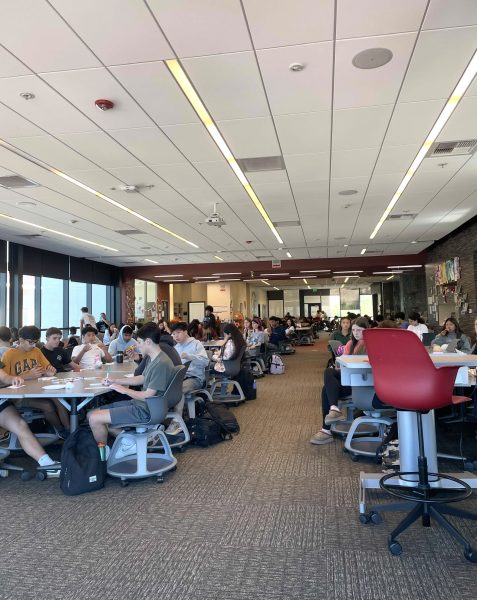The Arts: Are They Out of Style?

Monte Vista High School drama teacher, Christopher Connor, is lecturing his stage productions class. Class sizes for him and other art teachers have decreased.
The arts form the foundation of our culture and history, and they hold stories of the successes and failures of past generations. They are as important today as they were in the past, and yet today there is so little value placed on the arts, specifically in schools. When in the past the study and practice of poetry, music, and art were considered sophisticated, today people view them as nothing more than a side hobby.
The lack of appreciation for art comes from the notion that its “opposite” field, STEM (science, technology, engineering, and mathematics), is more practical. The issue isn’t that STEM careers don’t benefit society, but it’s that they are seen as the only ways to benefit society. This idea is nurtured by schools and parents, creating a never ending spiral; If colleges decide to put more value on STEM students, high schools will push STEM classes in the hopes that they will produce more STEM graduates. As a result, more parents will pressure their children into taking STEM classes.
Monte Vista High School (MVHS) offers its students a selection of 29 advanced classes (Honors and AP classes), roughly 44% of which are art related classes such as English, history, and visual arts. Of those classes, some are only a semester long, compared to a full, two semester long class. With numbers like these, high schools are communicating a clear message: The arts are a choice, STEM is not.
Some could argue that by making the arts voluntary, students are given the opportunity to choose their path in life as opposed to having it forced on them. If that is the case, then why are so many math and science classes mandatory for students, while things like theater arts are “for fun”?
“Freshmen were able to take a standard range of classes and be able to fit in an elective,” Christopher Connor, the drama teacher at MVHS said, “Once they made Biology standard for freshmen, those numbers began to shrink.”
Nowadays, the futures of students are decided by their parents, high schools, and universities. The combination of schools and parents pushing for STEM puts a pressure on students, and I, like many other students, have felt this pressure. Whether it comes from home, or the universities they want to apply to one day, the move towards STEM related careers is undeniable for many students.
As somebody who has a love for the arts, specifically writing, the lack of English honors and AP classes frustrates me. There are only two AP English options presented at MVHS, so those who want to pursue a writing or English related career and would like to boost both their knowledge and GPA have to search elsewhere. Students who tend to lean towards STEM are given more opportunities to bolster their GPA and their knowledge thanks to the wide array of honors and AP STEM classes offered. Students who want to pursue arts related careers are not given the same opportunities, nor do they receive the same attitude when sharing their future career plans. Arts students are left with a choice: Do they go with the flow and pursue a field of study they are not interested in if it means they stand a better chance of getting into college? Or do they stick with their arts related interest and the lack of opportunities that come with it?
The problem is a complex one, and the solution is even more complex. This isn’t something that can be fixed overnight, but in order for it to be fixed at all, it requires the support of schools at all levels, and beyond that, parents. If universities place a higher value on the arts, high schools will no longer force STEM on students if they want to graduate. And with the promise of a degree and money, parents are more likely to accept their child’s area of study. There are bigger issues surrounding the push for STEM classes, but it would take a much longer article to address those topics. Instead, we can start small. If you are a student, do what you love, not necessarily what you think will put you ahead of your class. If you are a parent, encourage your children’s passions, be it art or math. And although it may take some time, high schools should provide their students with more opportunities to pursue the arts because, as Connor said, “Art is what helps us to understand ourselves and the world. We need to foster the need and desire to create!”

Mia Garcia is a senior and in her second year on The Stampede. This year, she will be one of the Arts...






